Elastic AI Assistant for Observabilityで状況に応じたインサイトを獲得
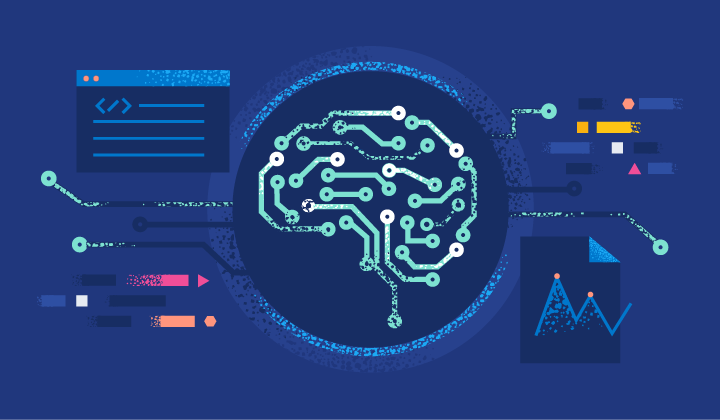
Elastic®では、Elasticsearch Relevance Engine™(ESRE)を搭載したオープンな生成AIアシスタントのElastic AI Assistantについて、オブザーバビリティ分析を強化するとともに、あらゆるスキルレベルのユーザーにご利用いただけるよう拡張を進めています。Elastic AI Assistant(オブザーバビリティ向けにテクニカルプレビュー中)では、対話型アシスタントが状況に応じた情報をSREへ提供します。これにより、問題の特定と解決プロセスが一変し、サイロ化したデータを手動で探し回る必要がなくなります。
Elastic AI Assistantを活用することで、アプリケーションエラーに対する理解を深め、ログメッセージをより適切に解釈し、高度なアラート分析を行えます。また、コードの効率を最適化するためのアイデアも得られます。さらに、SREはElastic AI Assistantの対話型チャットインターフェースを通じて、関連するすべてのテレメトリーを1か所で視覚化するとともに、独自データやランブックを利用してAIの状況認識を補強できます。
Elastic AI Assistantは任意のLLM(OpenAI、Azure OpenAIなど)と接続するように構成されていますが、非公開の情報をAI Assistantに提供することも可能です。このような非公開情報の例としては、ランブック、過去のインシデント記録、ケース履歴などがあります。AI AssistantはElastic Learned Sparse EncodeR(ELSER)ベースの推論プロセッサーを活用し、質問への回答やタスクの遂行に必要となる最も関連性の高いデータにアクセスします。
AI Assistantは学習機能を備えており、利用に応じてナレッジベースが成長します。SREから特定の問題について訓練を受けることで、今後同じシナリオが生じた際にサポートを提供できるようになるほか、障害レポートの作成、ランブックの更新、自動根本原因分析の強化の支援も可能になります。SREは、Elastic AI Assistantと機械学習を組み合わせて利用することで、サイロ化したデータを手動で探し回る手間をなくし、問題をより迅速かつ能動的に特定、解消できます。これにより、AIOpsが大幅に強化されます。
本記事では、8.10で提供される以下のテクニカルプレビュー段階の初期機能をご紹介します。
- Elasticのあらゆる画面からアクセスできるチャット機能
- 以下の用途で状況に即した情報を得るための事前作成済みLLM用クエリ:
- ログのmessageの意味を理解する
- Elastic APMの管理対象サービスについてエラーの扱いを改善する
- ログアラートの状況をより広く把握し対処案を特定する
- ユニバーサルプロファイリングでコードの最適化方法を理解する
- Elastic監視対象ホストで実行されているプロセスの内容を把握する
以下の動画でも同様のシナリオに沿って機能を紹介していますので、あわせてご覧ください。
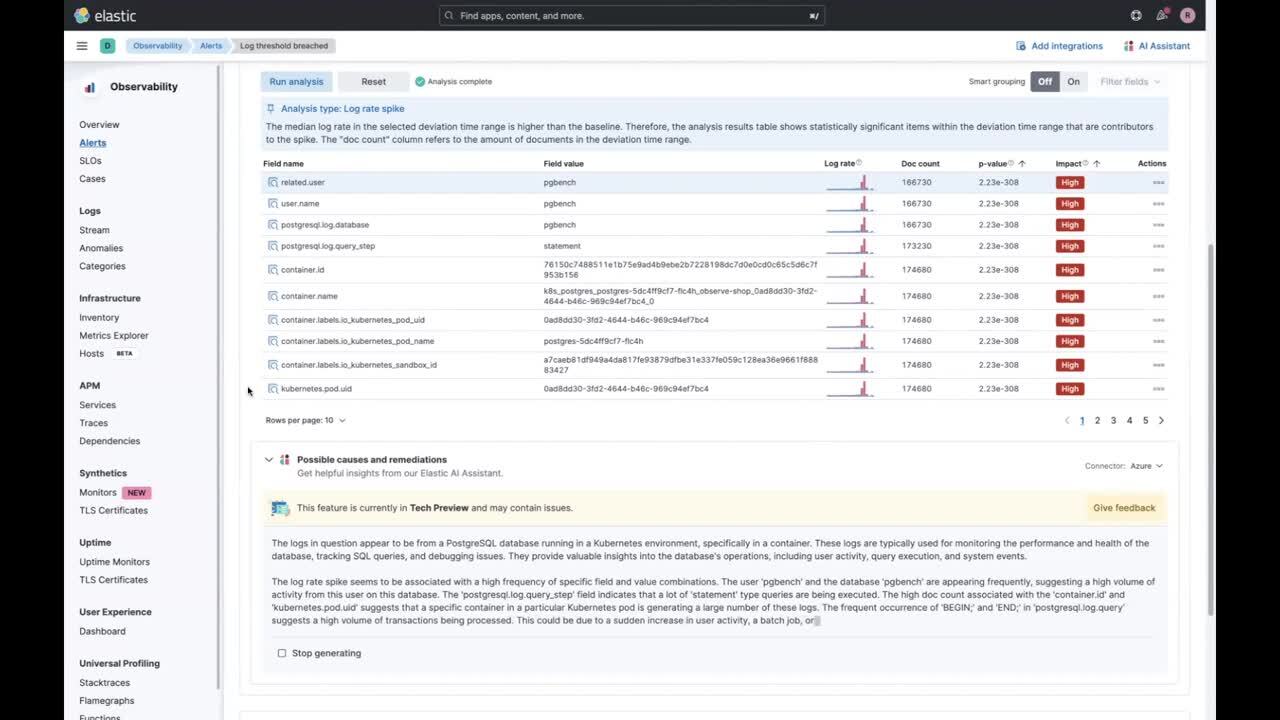
Elastic AI Assistant for Observability
SREの元には日々、ログエントリの数についてしきい値を超えたことを示すアラートが届きます。Elasticオブザーバビリティでは、こうしたアラートに加えて、問題の把握に役立つ関連ログの増加状況の分析結果もリアルタイムで提供されます。
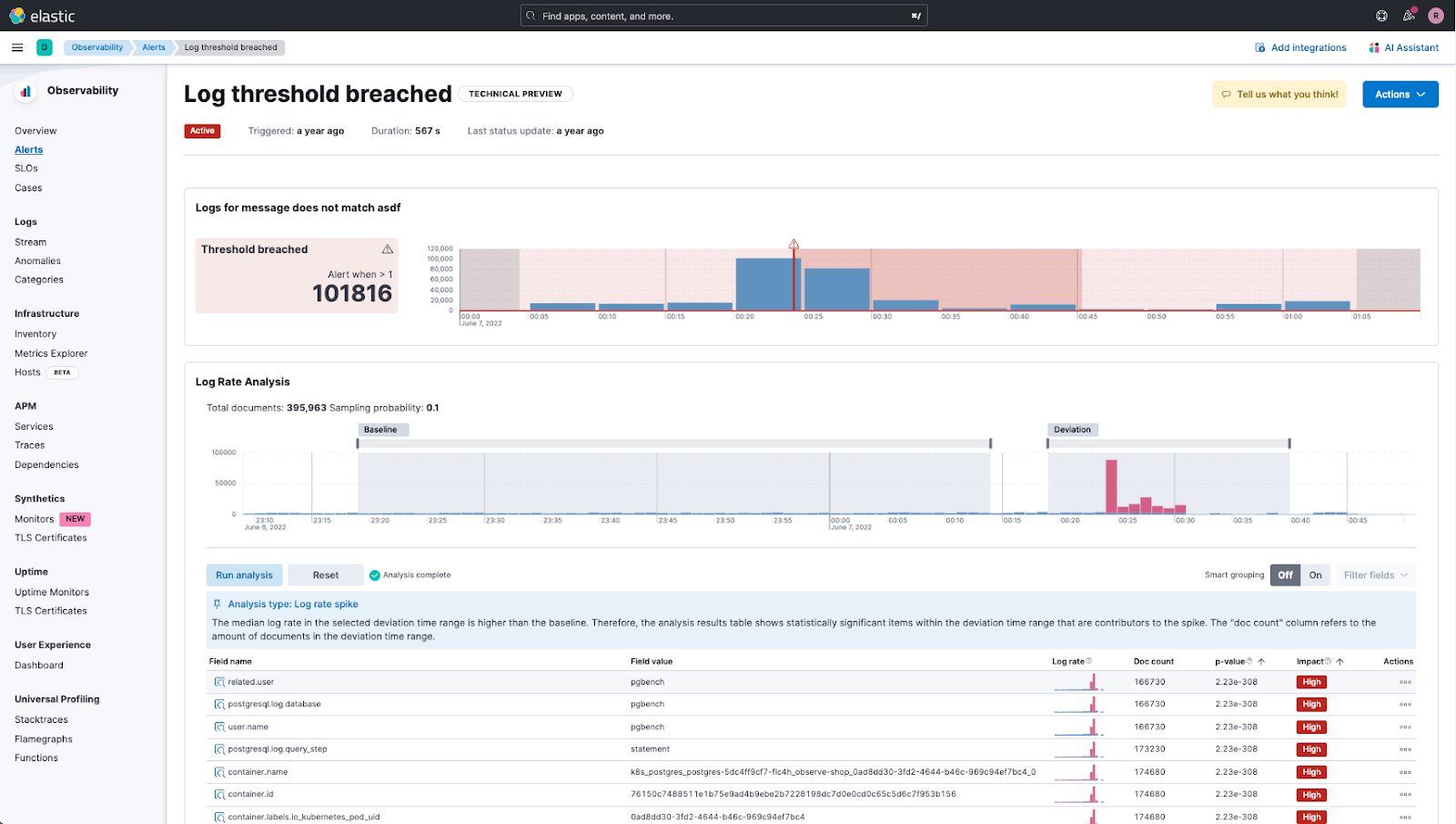
AI Assistantを利用した問題分析
しかし、SREは必ずしも担当システムのすべてを詳しく理解しているとは限らず、ログの急増を分析するうえで手助けが必要になる場合があります。そこで、AI Assistantが役立ちます。
Elasticでは、構成可能なLLMに送信するプロンプトをあらかじめご用意しています。このプロンプトにより、問題の説明や状況はもちろん、対処方法の案も入手できます。
また、AI Assistantとチャットして、詳しい調査を進めることも可能です。
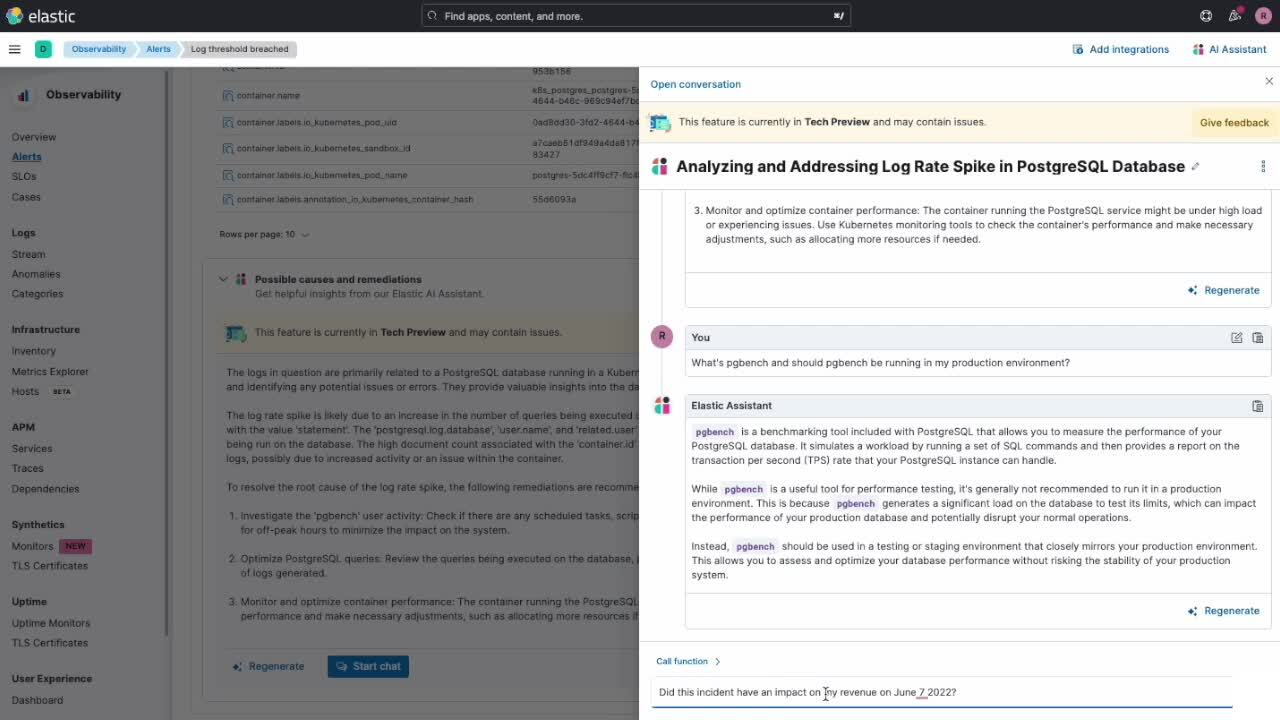
上の動画では、「pgbench」の問題について詳しい情報を得るだけでなく、組織内部の情報を得て、ビジネスへの問題の影響の調査も行っています。その結果、次のことがわかりました。
- トランザクションのスループットレートの急変が収益に与える影響
- このログ急増が発生した際の収益の低下状況
これらの情報はともに、質問への回答に必要であるもののLLMの学習対象にならない組織の(非公開)データをELSERで取得することにより得られました。
AI Assistantのチャットインターフェース
次は、新しいAI Assistantのチャットインターフェースの機能について説明します。このチャット機能では、Elastic AI Assistantとの議論や会話を通じて、以下の処理を実行できます。
- 自然言語で質問をして問題判別や根本原因分析を進める(例:「今日このサービスに関連するアラートはありましたか?」、「これらのアラートの意味を説明してください」)
- 社内のプライベートデータ(ELSERを使用)および接続済みのLLMで利用可能な情報に基づいて結論とコンテキスト、および今後の手順や推奨事項を得る
- クエリに対する応答やElastic AI Assistantで実行された分析の出力を分析する
- 会話で出た情報を振り返り、要約する
- 会話を通じてLensによる可視化を行う
- チャットインターフェースからKibana®やElasticsearch®のAPIを実行させる
- APM関数を使用して根本原因分析を行う(例:get_apm_timeseries、get_apm_service_summary、get_apm_error_docuements、get_apm_correlations、get_apm_downstream_dependencies)
AI Assistantへのアクセスポイント
Elastic AI Assistant for Observabilityのチャット機能は、まずElasticオブザーバビリティ8.10にて複数の場所で提供され、以降のリリースでさらにアクセスポイントが追加される予定です。
- すべてのオブザーバビリティアプリケーションの上部アクションメニューに、AI Assistantを起動し会話を始めるためのボタンが追加されます。
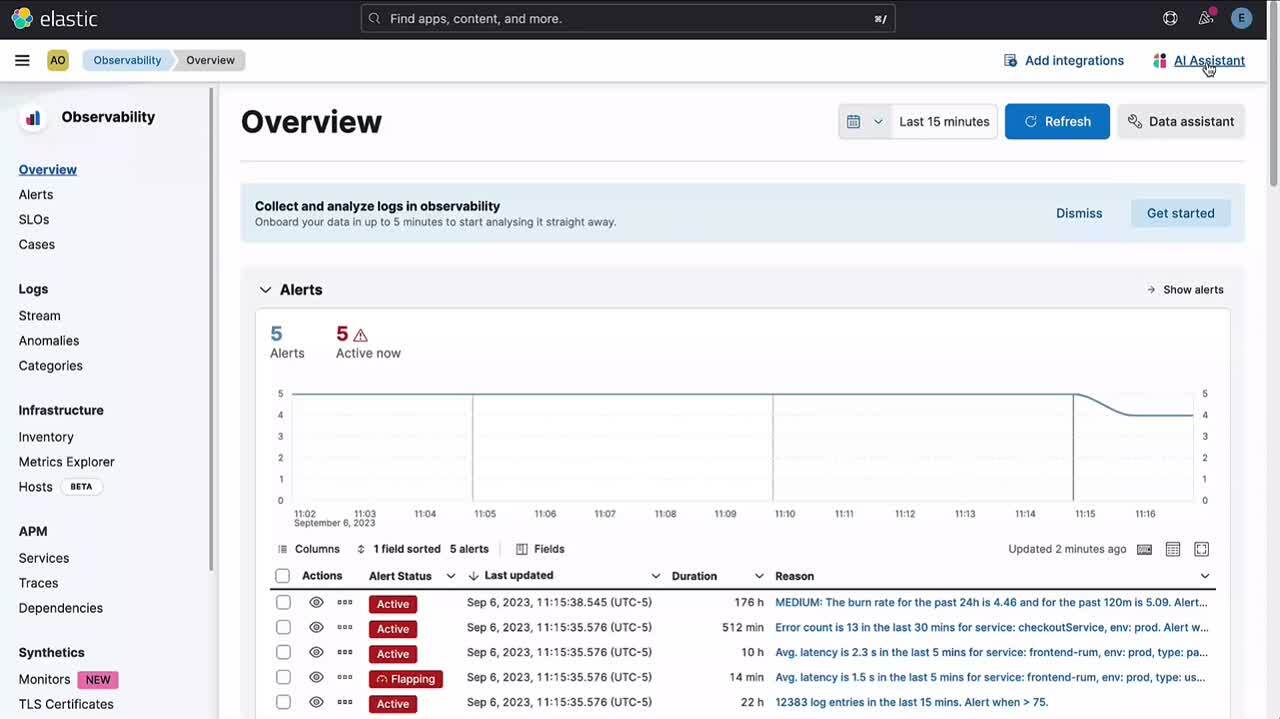
- ユーザーはAI Assistantの[Go to conversations](会話に移動)リンクをクリックして、過去の会話にアクセスするか新しい会話を始めることができます。
Elastic AI Assistant for Observabilityの新しいチャット機能では、Elastic AI Assistantですでに提供されているAPM、ログ、ホスト、アラート、プロファイルのインサイトに関する会話を行えます。これにより、Elasticオブザーバビリティ8.9で導入された機能をさらに活用できるようになります。
いくつか例をご紹介します。
- APMでは、アシスタントが該当するエラーや例外の意味を説明し、一般的な原因や考えられる影響を提示します。また、会話を通してさらに調査を進めることも可能です。
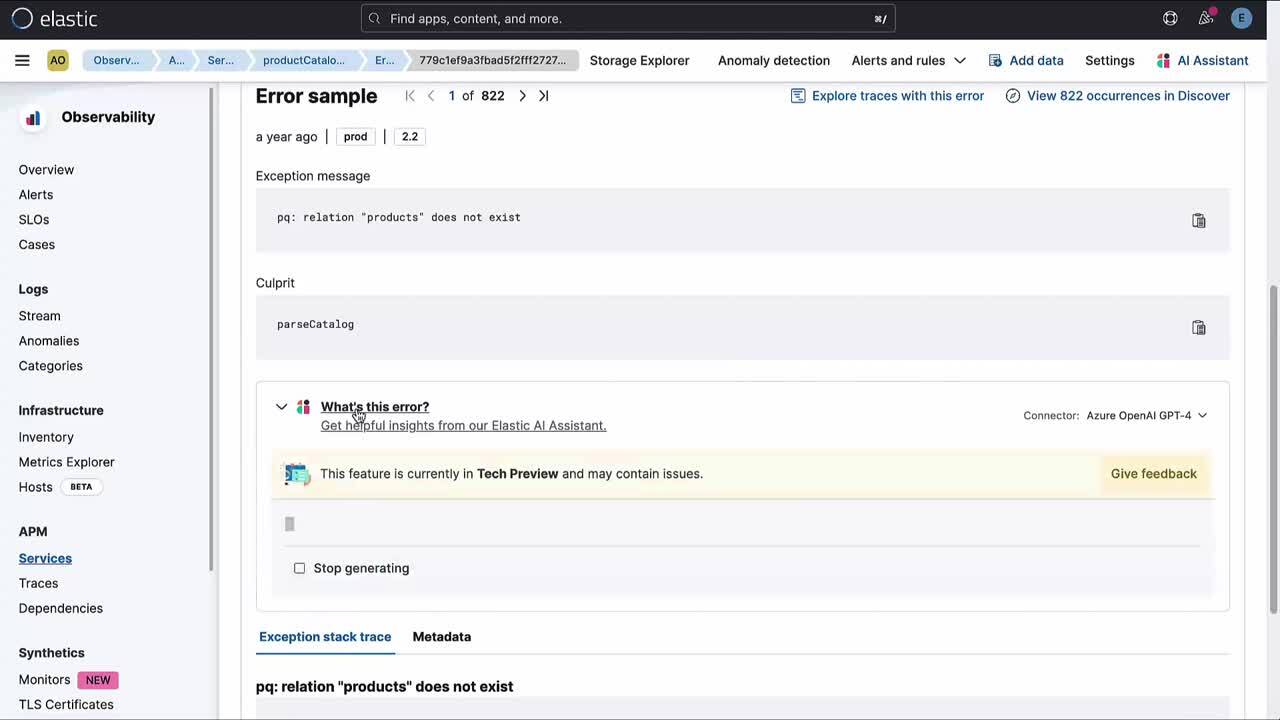
- ログでは、AI Assistantがログを取得し、状況に応じた情報を補足してメッセージを解説します。また、会話を通じて詳しい調査も行えます。
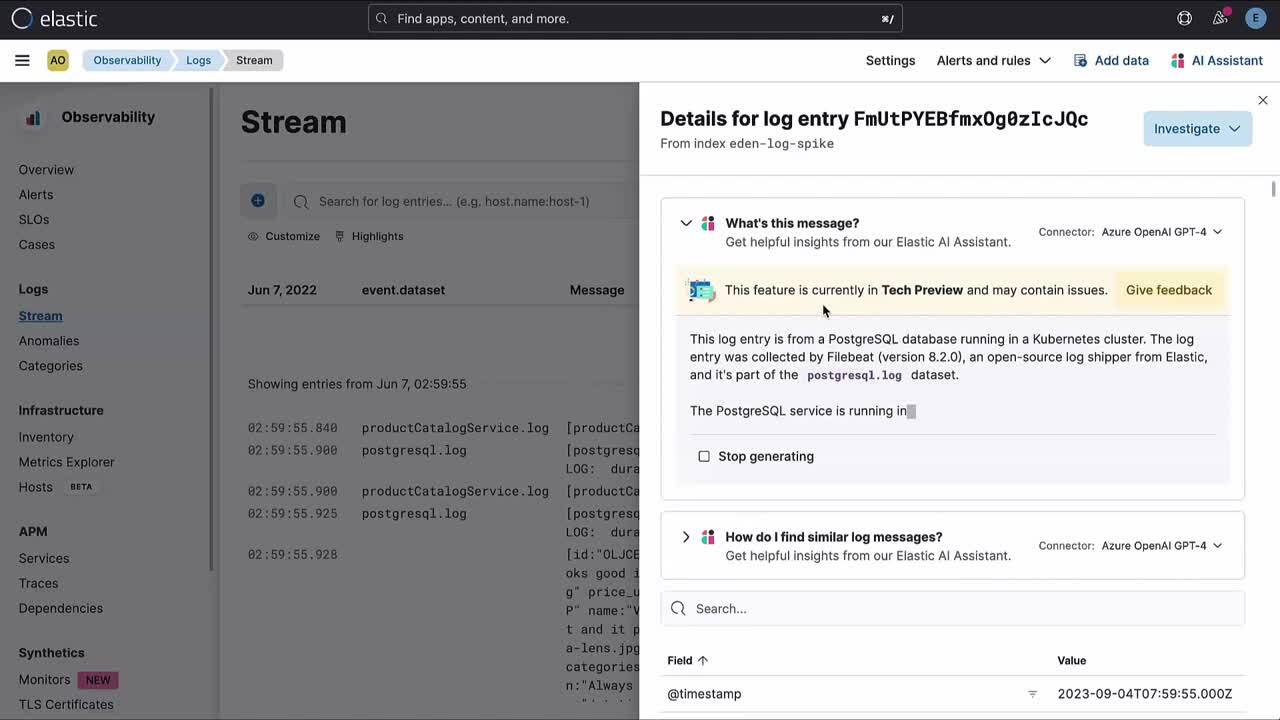
AI Assistantの構成
Elastic AI Assistantの詳しい構成手順については、Elasticドキュメントを参照してください。
このアシスタントはコネクターベースであり、初期リリースではOpenAIとAzure OpenAIの構成に対応します。ただし、GPT-4の使用が推奨され、関数呼び出しのサポートが必須です。OpenAIを直接使用する場合、これらの機能は自動的に提供されます。Azureバージョンを使用する場合は、Azureのドキュメントに従って、いずれかの最新モデルをデプロイしてください。
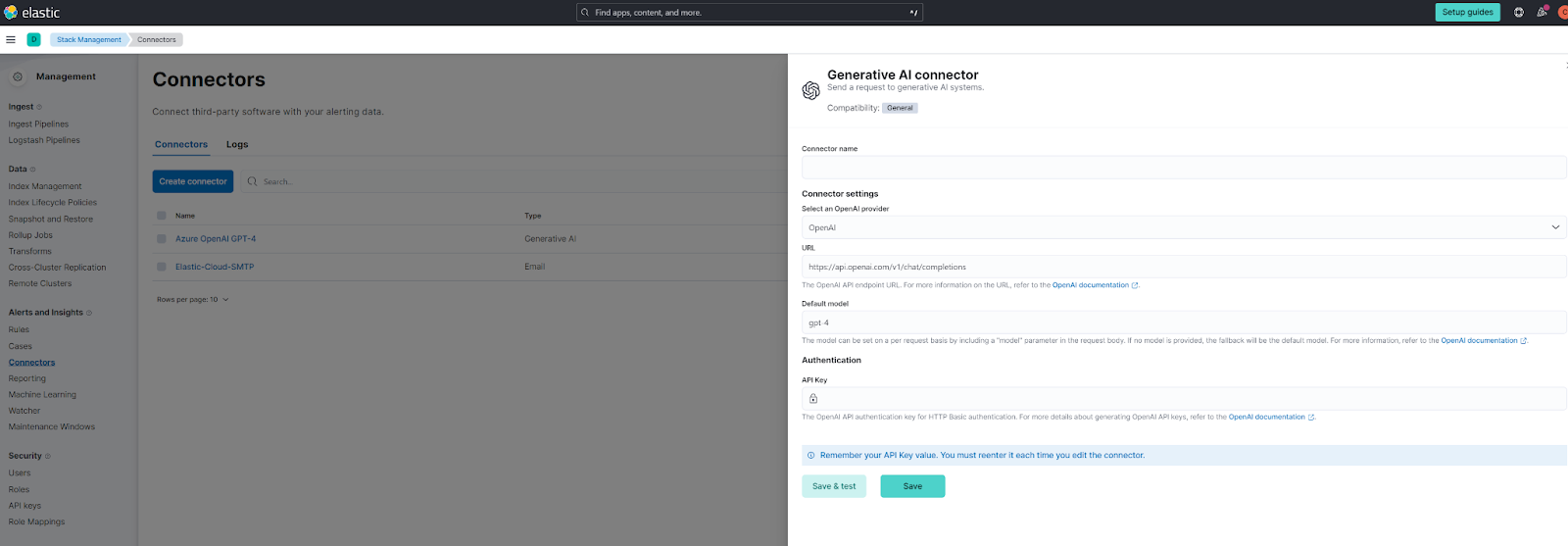
また、yamlを使用して、事前構成済みのコネクターとして構成することもできます。
xpack.actions.preconfigured:
open-ai:
actionTypeId: .gen-ai
name: OpenAI
config:
apiUrl: https://api.openai.com/v1/chat/completions
apiProvider: OpenAI
secrets:
apiKey: <myApiKey>
azure-open-ai:
actionTypeId: .gen-ai
name: Azure OpenAI
config:
apiUrl: https://<resourceName>.openai.azure.com/openai/deployments/<deploymentName>/chat/completions?api-version=<apiVersion>
apiProvider: Azure OpenAI
secrets:
apiKey: <myApiKey>本機能を利用できるのは、エンタープライズライセンスの所有者のみです。Elastic AI Assistant for Observabilityはテクニカルプレビューの段階であり、エンタープライズライセンスの機能として提供されます。Elasticエンタープライズに加入されておらず、Elastic AI Assistant for Observabilityへのアクセスを希望される場合には、ライセンスのアップグレードをご検討ください。
Elasticではお客様からのフィードバックを重視しています。Elastic AI Assistant付属のフィードバックフォーム、Discussフォーラム(AI AssistantタグまたはAI operationsタグを使用)、ElasticのコミュニティSlack(#observability-ai-assistant)からご意見をお寄せください。
最後に、本機能はまだテクニカルプレビュー段階であることをご了承ください。大規模言語モデルの性質上、アシスタントは時折予想外の挙動を示す可能性があります。同じ状況でも、応答が常に同一であるとは限りません。また、答えられそうな質問を受けた場合であっても、対応できないと回答する場合もあります。
アシスタントの耐障害性および予測性の向上と全体的な改善に取り組んでいますので、今後のリリースにご期待ください。
試してみる
ご紹介した機能について詳しくは、Elastic AI Assistantのページまたはリリースノートをご覧ください。
Elastic Cloudをご利用中のお客様はElastic Cloudコンソールから直接、本記事でご紹介した機能にアクセスできます。Elasticをクラウドでご利用中でない場合は、無料トライアルでお試しください。
本記事に記述されているあらゆる機能ないし性能のリリースおよびタイミングは、Elasticの単独裁量に委ねられます。現時点で提供されていないあらゆる機能ないし性能は、すみやかに提供されない可能性、または一切の提供が行われない可能性があります。
このブログ記事では、それぞれのオーナーが所有・運用するサードパーティの生成AIツールを使用したり、参照したりしている可能性があります。Elasticはこれらのサードパーティのツールについていかなる権限も持たず、これらのコンテンツ、運用、使用、またはこれらのツールの使用により生じた損失や損害について、一切の責任も義務も負いません。個人情報または秘密/機密情報についてAIツールを使用する場合は、十分に注意してください。提供したあらゆるデータはAIの訓練やその他の目的に使用される可能性があります。提供した情報の安全や機密性が確保される保証はありません。生成AIツールを使用する前に、プライバシー取り扱い方針や利用条件を十分に理解しておく必要があります。
Elastic、Elasticsearch、ESRE、Elasticsearch Relevance Engine、および関連するマークは、米国およびその他の国におけるElasticsearch N.V.の商標、ロゴ、または登録商標です。他のすべての会社名および製品名は、各所有者の商標、ロゴ、登録商標である場合があります。